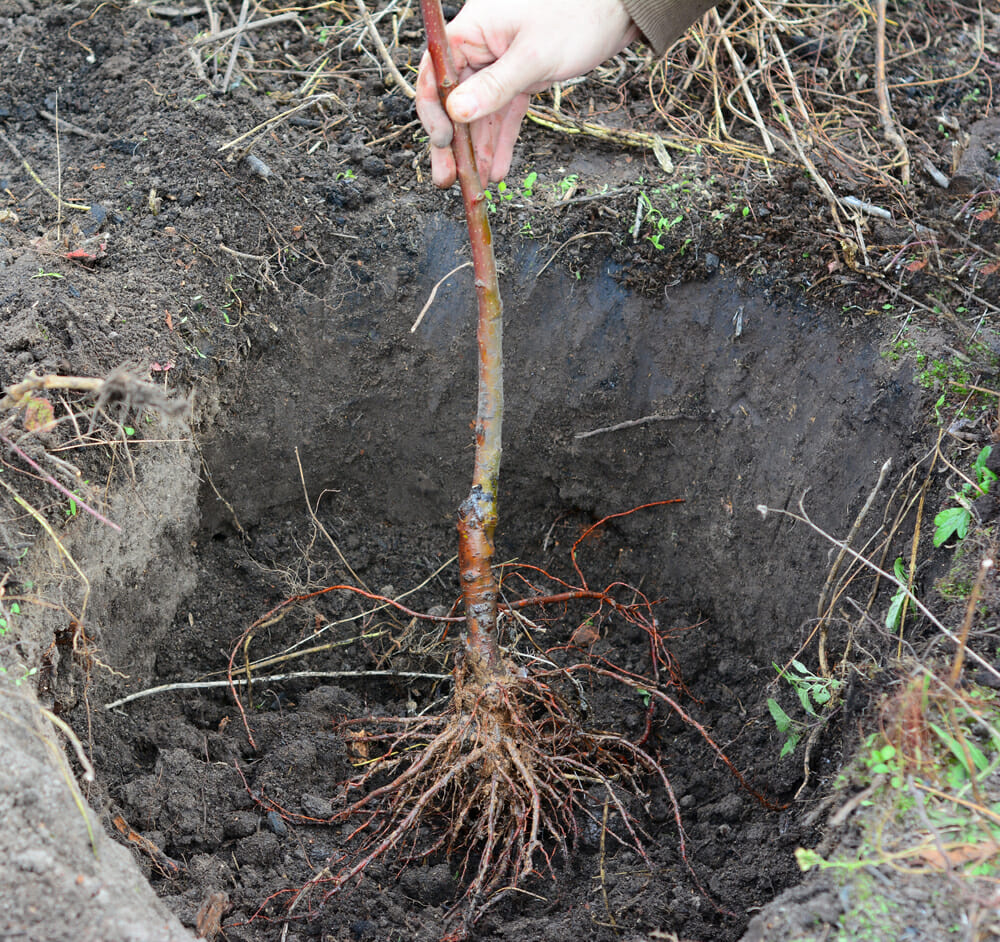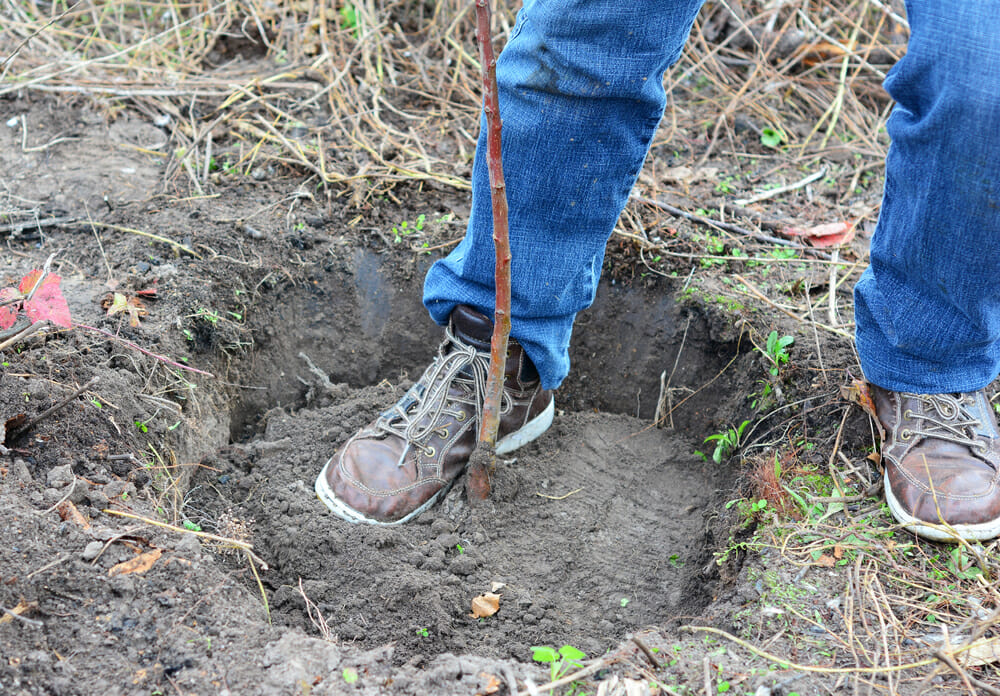Last Updated on January 27, 2022 by Zachary Smith

If you want to establish an orchard on your property or just add a few fruit trees, bare root trees are an excellent option.
Sold without pots or dirt, bare root fruit trees are a resilient, affordable choice that can help your orchard establish itself faster.
Here at Zachary Smith Arboriculture, we help clients across the Bay Area learn how to plant bare root fruit trees. Whether you’re planting an apple, avocado, fig, lemon, pear, pluot, or pomegranate tree, our team is here for you.
In this blog, we’ll discuss how to plant bare root trees successfully on your property.
Let’s dig in.
Bare Root Vs. Potted Fruit Trees: Which is Better?
When you buy a fruit tree for your property, you have two choices: a potted tree (the most common option at greenhouses and garden stores) or a bare root tree, which is sold in a dormant state with no soil around the roots.
While people tend to be most familiar with potted trees, bare root trees can be a great pick for anyone who wants to save money and plant many trees at once.
Here’s a breakdown of both options:
Bare Root Trees

- Appearance. As deciduous plants, fruit trees are dormant during the winter. This is why you can only get bare root trees from late fall to early spring. While potted fruit trees are grown in a container and sold year-round, bare root trees don’t have many (or any) leaves and are not actively growing. When you buy these trees, they look like sticks with some roots on the end. They are shipped during dormancy and can survive for limited periods with no soil surrounding their roots – hence the name “bare root.” Don’t fear, though – these trees are alive and healthy and will start growing quickly once you put them in the ground!
- Variety. If you want to plant a diverse orchard, you’ll find that there are more varieties of bare root fruit trees available. Typically, you must order them through a nursery or pick them up at a greenhouse.
- Root health. Bare root trees are never pot-bound when you receive them. While pot-bound trees will begin to grow lateral roots eventually, it can take several years after planting. The roots of bare root trees, on the other hand, begin to splay outward as soon as you place them in the soil.
- Affordability. Bare root trees are a popular option among people who want to plant numerous trees at once since they’re significantly more affordable than potted fruit trees. Some specialty nurseries also offer bulk discounts for people ordering many fruit trees.
- Resilience. Because bare root trees were never in a pot, they’re less likely to experience shock and moisture loss upon planting. Additionally, bare root trees don’t have to transition from container soil to native soil. This allows them to establish more quickly and to bear fruit faster.
Potted Trees
- Availability. Potted trees are by far the most common variety available. In most areas, you can find them available for purchase year-round. Additionally, if you just want one or two fruit trees, it’s easier to purchase small numbers of potted trees than it is to order bare root trees.
- Planting. When you buy a potted fruit tree and take it home, you don’t have to plant it right away. In fact, some small potted fruit trees (like Meyer lemon, for example) can live their whole lives in a container.
- Risk for root girdling. The downside of potted trees is that the roots can be girdled (or “pot bound”) when you purchase the tree. Because of this, they’re more prone to shock after planting, and they usually take longer to get established once you put them in the ground.
- Cost. Potted trees are more expensive than bare root trees.
When is the Best Time to Plant a Bare Root Fruit Tree?
The best time to plant a bare root fruit tree is in the early spring. Because bare root trees arrive in a dormant state, they need to be planted before they begin producing buds.
As soon as the trees encounter sun and heat, they’ll emerge from dormancy. If they’re not in the soil by then, they’ll become stressed and die.
Because bare root trees have no soil around their roots, they need access to high-quality soil and ample water and nutrients as soon as they’re planted.
Putting them in the ground in the early spring ensures access to these nutrients and allows the tree to start growing immediately.
Before You Get Started, Do This First
Ready to plant some bare root fruit trees? Do these things to ensure a successful planting process:
1. Properly store the tree if needed

Bare root trees are grown at specialized fruit tree nurseries. The nurseries plant the trees in soil, and then dig them out of the ground during the early spring or late fall, when the tree is dormant and has no flowers, leaves, or fruit.
They wash the soil off the roots, wrap them in damp mulch or hay, and cover them with plastic to keep them hydrated. The tree can then be shipped to its destination.
Once you receive a bare root tree, you need to keep it cool (but not freezing) and dark until you’re ready to plant it. Make sure the roots stay wrapped, as well, to keep them moist and safe.
If you need to buy yourself some extra time, you can dip the roots into a hydrogel slurry, which will protect the tree for an extra week, at most.
After dipping, leave the slurry on the roots and secure a large plastic bag around the base of the tree to lock the moisture in.
Cover the bagged roots with a tarp and keep the tree in a cool, dark location until you’re ready to plant.
2. Prepare the tree
Before you plant the tree, soak the roots for at least 2 hours, or up to 8-12 hours.
Here’s how:
Carefully remove the packing material surrounding the roots and soak the entire root system in a large bucket of room temperature water.
This important step rehydrates the roots and prepares them to absorb water and nutrients in the ground. Be careful never to soak bare root trees for longer than 24 hours, however, since this can damage them permanently.
Proper care for bare root fruit trees before planting ensures healthy growth and a long life for your new trees.
3. Gather your supplies
Next, gather everything you’ll need to plant the tree.
We recommend collecting a spade, a good digging shovel, high-quality garden compost and mulch, and a tree stake and tie. You’ll also want a wheelbarrow or large bucket to put soil in as you dig the hole and easy access to a hose and running water.
4. Prepare the soil
Next, prepare the soil in the area where you intend to plant the bare root tree.
Dig a square hole (which promotes natural root splaying) that is deep enough to accommodate the height of the tree’s root system and is at least one and a half times the width of the root mass. Remove and dispose of all sod you dig up.
Using a spade, break up any compacted soil and loosen the dirt on the bottom and sides of the hole. Remove weeds, debris, rocks, hard clumps of earth, and other materials that could interfere with root growth.
Before you position the tree, add a few shovelfuls of compost, mixing it into the native soil until the mixture is well-blended. Finally, fill the hole with water and allow it to drain.
How to Plant a Bare Root Fruit Tree: 6 Important Steps

Now that you’ve prepared your soil, it’s time to plant the tree. Follow these steps to give your new addition a strong start:
1. Create the right soil mixture
Take the native soil you’ve removed from the ground and blend it in a wheelbarrow with equal parts high-quality compost.
This lightens the soil, infuses it with important nutrients, and helps set your tree up for success.
2. Position the tree correctly
Next, retrieve your tree and place it in the middle of the hole, making sure it is centered and not too close to either side of the hole.
For best results, we recommend planting the tree a bit “high.”
Here’s what we mean:
Add enough of your newly mixed soil to the bottom of the hole so the tree sits with about a quarter of its root system higher than the grade surrounding it. As you fill the hole, taper the soil to cover all the roots, angling the soil away from the tree’s trunk.
The reason for this is simple:
Newly disturbed soil settles easily, and trees that are planted at grade may settle below grade as this happens. Being below grade puts fruit trees at risk of disease and root rot.
Planting “high,” however, allows the tree to settle just above grade. This promotes good drainage and optimal root health. If you’re planting a grafted tree, make sure the grafting joint on the tree’s trunk is above soil level.
3. Firm the soil
When the hole is full, gently stabilize the tree with one hand and use your foot or hand to lightly compact the soil around the tree, firming it into place. Water the soil thoroughly to remove air pockets and settle the soil.
4. Add the Finishing Touches
Stake the tree to encourage straight growth, and then spread a 3” layer of mulch around the base of the tree. This helps the newly planted tree regulate temperature and retain moisture.
Be sure to leave about 2” of mulch-free area around the base of the tree’s trunk to prevent fungal growth. If you’re going to install a drip irrigation system or a soaker hose, jump ahead to step #5, and wait to add mulch until the hose is in place.
5. Water properly until the tree is established
Once your tree is in the ground, your most important job is to water it regularly until it is established – which could take months.
The best way to ensure proper irrigation is to use soaker hoses or drip irrigation systems, which ensure slow, deep watering. Adding a portable, battery-operated timer ensures proper irrigation amounts while saving you time in the process.
6. Hold off on fertilizing
Many people think that fertilizing right away is the best way to ensure a healthy tree. And that makes sense, given that proper fertilization is a key component of organic lawn care.
If you’re going to fertilize a bare root tree, though, we recommend waiting until your tree has established itself.
Wait a few months after planting, and then apply a slow-release fertilizer, which won’t burn your tree’s roots. The team here at Zachary Smith Arboriculture will be happy to recommend the best fertilizer for your location and tree species.
How do I Plant a Bare Root Fruit Tree in Clay Soil?

If you have heavy, clay soil on your property, you can still plant bare root fruit trees — you’ve just got to be careful about how you do it.
Traditionally, bare root trees are planted by digging a deep hole in the ground and placing the tree gently in the middle. If your soil is poorly drained or heavy, though, this method may suffocate the tree.
Instead, you’ll need to adjust your planting tactic just a bit and plant the tree on a mound.
Here are the steps to follow:
- Dig a hole. The hole should be deep enough to accommodate the height of the tree’s root system, and at least one and a half times the width of the root mass. Loosen the soil in the bottom and sides of the hole to promote lateral root growth. If you’re planting several trees at once, dig in a straight line, maintaining the width and depth of the trench throughout. Plan for at least 3-5” between trees.
- Create a mound of prepared soil. Using a 50/50 mixture of native soil and high-quality compost (which helps lighten the soil and promote drainage), create a mound at the bottom of your newly dug hole. When you position the tree on the mound, its root flare should be slightly above the surface of the soil, so moisture will run down to the end of the roots, rather than gathering toward the trunk of the tree and causing it to sit in water.
- Drape the roots over the mound. As you position the tree, drape the roots over the soil mound. Make sure they are not cramped or bending back on themselves. Fill the hole with a mixture of native soil and compost, gently compacting it as you go. If you’re planting a grafted tree, make sure the grafting joint on the tree’s trunk is above soil level.
- Water thoroughly. Settle the soil and get rid of air pockets by watering the tree thoroughly.
- Add mulch. Mulch the tree with 2-3” of high-quality mulch, maintaining a 2-3” mulch-free zone around the trunk.
How Do I Plant a Bare Root Fruit Tree in a Pot?

Smaller bare root fruit trees can thrive in containers – if you plant them correctly.
For best results, follow these tips:
- Soak the roots first. Just like you would with a larger tree, soak the roots of your tree in a container of tepid water for at least 2 hours before planting.
- Choose the right container. Pick a container that’s large enough to accommodate at least two years’ worth of growth. Line the bottom with rocks to promote drainage.
- Add compost. Place a layer of compost at the bottom of the pot to cover the rocks. Place the tree in the middle of the container.
- Fill with soil. Use a mixture of compost and high-quality potting soil to fill the container and firm the tree into place.
- Stake the tree. Promote vertical, strong growth by inserting a stake into the compost and using a figure-eight knot with twine to avoid chafing or binding the tree’s bark.
- Water thoroughly. Soak the tree thoroughly, standing the pot on feet to ensure proper drainage. Water the tree regularly until it’s established.
As long as you follow these steps, you’ll have a beautiful fruit tree in a pot for years to come.
In the San Francisco Bay Area? Let us Take Care of Your Bare Root Fruit Trees!
Bare root fruit trees are more affordable than potted trees, and they come in many more varieties. Still, they can be intimidating to plant and care for.
Fortunately, you’re not in it alone. Here at Zachary Smith Arboriculture, we help residential properties in Northern California – from Marin to Monterey – plant and care for bare root fruit trees.
We also provide a variety of organic lawn care services to help you kill weeds naturally, get rid of crabgrass, and enjoy a greener, more beautiful outdoor space.
Contact us today to learn more about how to plant bare root fruit trees, or how we can help you maintain your trees for a bountiful harvest year after year.

